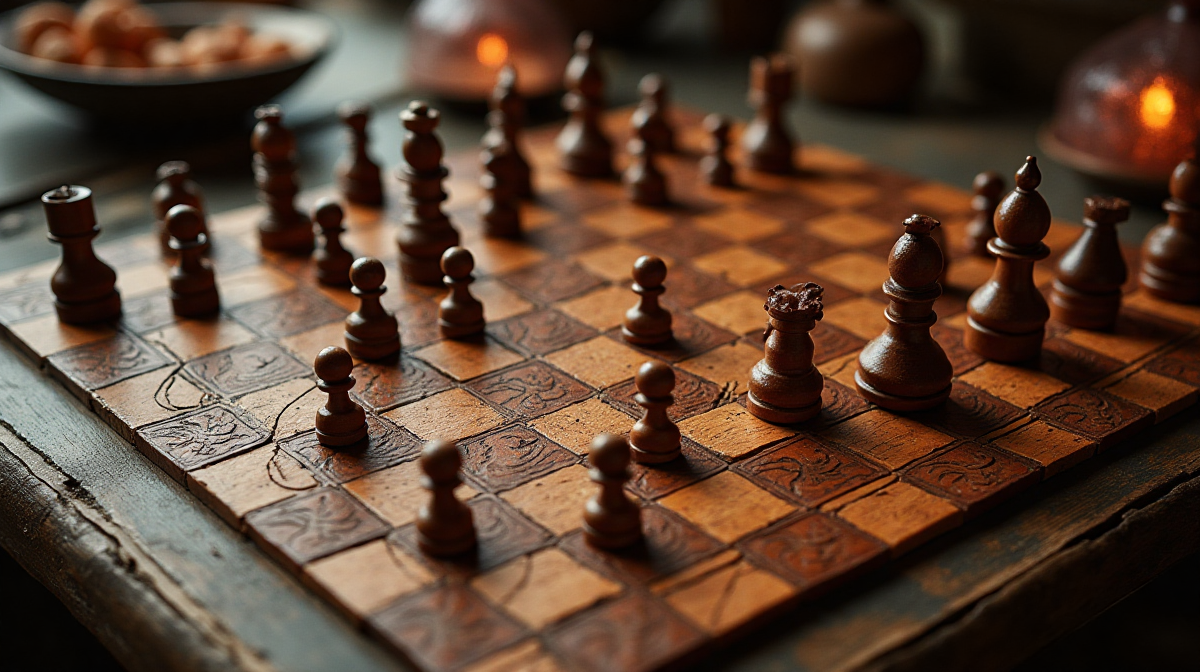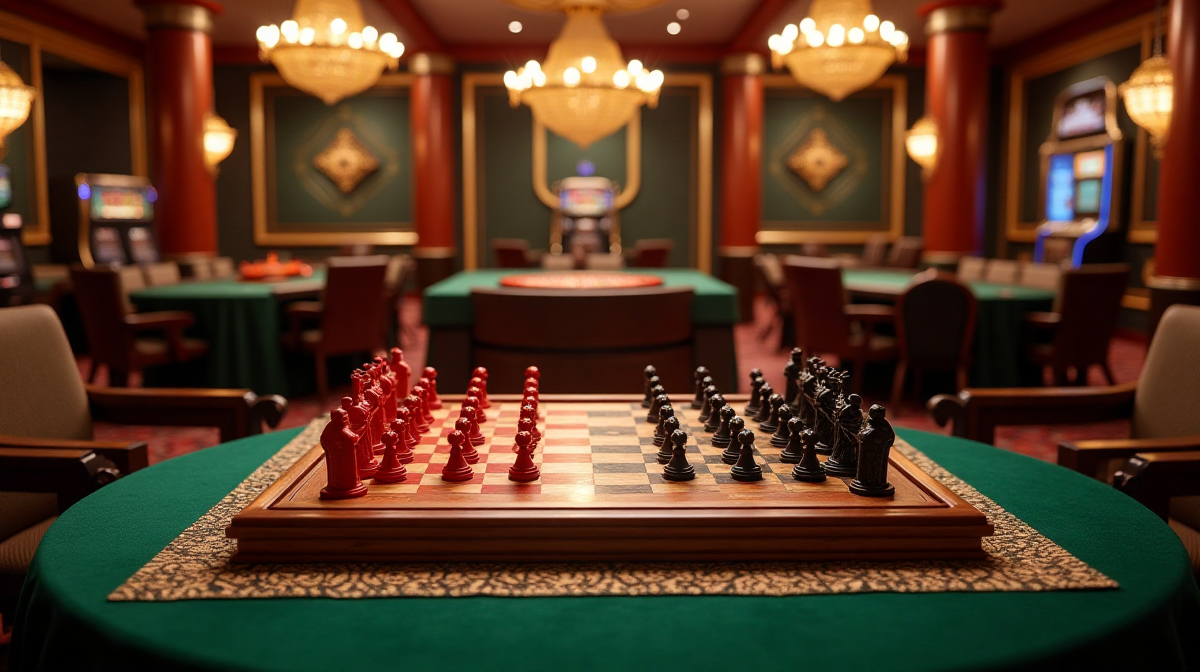Chinese Chess: Beginner’s Guide & Strategy
What is Xiangqi? - History & Origins
Xiangqi, also known as Chinese chess, is a strategy board game with a rich history stretching back over two millennia. Its origins are believed to be rooted in ancient Chinese warfare, evolving from earlier forms of board games. Unlike its Western counterpart, Xiangqi reflects Chinese military thinking and philosophy. Interestingly, even in the digital age, platforms like пин ап казино мобильная версия offer diverse entertainment, but the enduring appeal of strategic board games like Xiangqi remains strong. The game's cultural significance is profound, deeply ingrained in Chinese society and celebrated for its intellectual challenge.
The Xiangqi Board & Pieces – An Overview
The Xiangqi board is a rectangular board with 90 intersections formed by nine vertical lines (files) and ten horizontal lines (ranks). Pieces are placed on these intersections, not within squares as in Western chess. The pieces themselves are flat and circular, adorned with Chinese characters identifying their role. The two players, Red and Black, each command an army of 16 pieces, each with unique movement capabilities. The game demands foresight and strategic thinking, a far cry from simply trying your luck on a platform like пин ап.
Xiangqi vs. Western Chess - Key Differences
While both games share the goal of checkmating the opponent’s General (King), significant differences set Xiangqi apart. The river separating the two sides of the board restricts the movement of Elephants and Soldiers. The Cannon’s unique jumping attack adds a distinct tactical element. Furthermore, the board layout and piece values differ substantially, leading to different strategic priorities. A frustrating experience, like пин ап не пришли деньги, can highlight the importance of clear rules and reliable systems, something Xiangqi upholds with its defined structure.
Why Learn Xiangqi? - Benefits & Appeal
Learning Xiangqi offers numerous cognitive benefits. It enhances logical thinking, problem-solving skills, and strategic planning. The game also promotes patience, concentration, and foresight. Beyond the mental workout, Xiangqi is a fascinating cultural experience, offering a window into Chinese history and philosophy. The beautiful pieces and intricate gameplay make it a captivating pastime, offering a different kind of thrill than online casinos.
The Pieces & Their Movements
The General - Rules & Restrictions
The General is the most important piece, and its capture results in immediate defeat. It’s restricted to the nine-point palace, moving only one intersection at a time horizontally or vertically. Direct confrontation between the two Generals is illegal.
The Advisors - Defensive Role & Movement
Advisors also reside within the palace, protecting the General. They move one intersection diagonally, remaining within the palace boundaries.
The Elephants - River Bound & Strategic Use
Elephants move two intersections diagonally, but are restricted to their own half of the board by the river. They cannot cross the river and are powerful defensive pieces when positioned correctly.
The Horses – The Knight of Chinese Chess
The Horse moves one intersection horizontally or vertically, then one intersection diagonally, away from the original position. It's often referred to as the “knight” of Chinese chess, though its movement is slightly different from the Western knight. Strategic Horse maneuvers can be key, similar to analyzing patterns in a game of knight chess.
The Chariots - The Most Powerful Piece
Chariots are the most powerful pieces, moving any number of unoccupied intersections horizontally or vertically. They are crucial for controlling the board and launching attacks.
The Cannons – Unique Jumping Attack
Cannons move like Chariots, but to capture, they must jump over exactly one piece (of either color) to land on the target square. This unique jumping ability makes Cannons formidable attacking pieces.
The Soldiers – Promotion & End Game Importance
Soldiers move one intersection forward. Once they cross the river, they gain the ability to move one intersection sideways as well. Upon reaching the opposite end of the board, they are promoted, gaining the movement capabilities of a chariot.

Setting Up the Board & Starting the Game
The Standard Starting Position
The pieces are arranged in a specific order on opposite ends of the board. The Generals face each other within their respective palaces, with Advisors flanking them. The other pieces are arranged in a symmetrical formation.
Board Orientation & Coordinates
The board is oriented so that the river runs horizontally between the players. Files are numbered 1-9 from right to left from the Red player’s perspective, and ranks are numbered 1-10 from top to bottom.
The Palace - Understanding its Significance
The Palace, a 3x3 area, is where the Generals and Advisors reside. It is a critical defensive zone, and protecting the General within the palace is paramount.
Legal Moves and Illegal Moves - A Beginner's Guide
A legal move must adhere to the piece’s movement rules and cannot result in self-check (placing your own General in check). Illegal moves are not permitted.
Basic Gameplay & Rules
Capturing Pieces - How it Works
Pieces are captured by moving your piece onto the intersection occupied by an opponent’s piece. The captured piece is removed from the board.
Check & Checkmate - Ending the Game
When the General is under attack, it is considered in check. The player in check must immediately resolve the threat, either by moving the General, blocking the attack, or capturing the attacking piece. If the General is in check and there is no legal move to remove the threat, it is checkmate, and the game ends.
Stalemate – A Draw Condition
If a player has no legal moves but their General is not in check, it is a stalemate, resulting in a draw.
Perpetual Check – Rules & Avoiding It
Repeatedly checking the opponent’s General without any meaningful progress is considered perpetual check and is generally illegal.
The Draw Rule – Agreement & Repetition
Players may agree to a draw. A draw can also be declared if the same position is repeated three times.
Fundamental Strategies for Beginners
Controlling the Center - Importance & Tactics
Controlling the center of the board provides greater mobility for your pieces and restricts your opponent’s options.
Developing Your Pieces - Early Game Priorities
Bring your pieces into play early in the game to maximize their potential.
Protecting Your General - The Most Crucial Task
The General’s safety is paramount. Prioritize defending it and preventing attacks.
Piece Coordination - Working Together for Attack & Defense
Coordinate your pieces to create a cohesive attacking and defensive force.
Understanding Pawn Structure – Weaknesses & Strengths
Pawn structure influences the flow of the game and can create weaknesses or strengths in your position.
Opening Principles – Common & Effective Approaches
Follow established opening principles to gain a favorable position.
Intermediate Strategies & Tactics
Cannon Attacks - Utilizing its Unique Ability
Mastering the Cannon’s jumping attack is essential for launching effective attacks.
Horse Maneuvers - Advanced Movement Techniques
Utilize the Horse’s unique movement to exploit weaknesses in your opponent’s position.
Elephant Control – Position and Weaknesses
Position your Elephants strategically to control key areas of the board.
Sacrifices – When and Why to Offer Pieces
Consider sacrificing pieces to gain a positional advantage or launch a decisive attack.
Forks, Pins, and Skewers – Tactical Motifs
Recognize and exploit these common tactical motifs to win material or create threats.
Exploiting Weaknesses in Your Opponent’s Position
Identify and capitalize on your opponent’s weaknesses.

End Game Strategies
Soldier Promotion - Making the Most of Your Pawns
Promote your Soldiers to Chariots to create powerful attacking pieces.
General vs. General Endgame – Common Patterns
Understand the common patterns in General vs. General endgames.
Chariot Endgames – Dominating the Board
Use Chariots to control the board and force a favorable outcome.
Cannon Endgames – Precision & Calculation
Cannon endgames require precise calculation and strategic positioning.
Drawing the Game in the Endgame
Know when and how to draw the game in the endgame.
Learning Resources & Practice
Online Xiangqi Platforms & Apps
Numerous online platforms and apps allow you to play Xiangqi against other players.
Books & Websites for Further Study
Many books and websites offer in-depth analysis of Xiangqi strategy and tactics.
Finding Xiangqi Opponents
Seek out opportunities to play against other players to improve your skills.
Analyzing Your Games – Identifying Improvements
Review your games to identify areas for improvement.
Watching Professional Xiangqi Matches - Learning from the Best
Study professional matches to learn advanced strategies and techniques.
Common Xiangqi Openings
Gold Coin Opening – Popular and Solid
The Gold Coin Opening is a popular and solid opening that focuses on developing the Cannon.
Flying Horse Opening – Aggressive and Tactical
The Flying Horse Opening is an aggressive and tactical opening that emphasizes early attacks.
Immortal Horse Opening - Specialized and Less Common
The Immortal Horse Opening is a specialized and less common opening that requires precise play.
Other Notable Openings - A Quick Look
Explore other openings to diversify your repertoire.
Frequently Asked Questions
What's the objective of Xiangqi?
The objective of Xiangqi is to checkmate the opponent’s General.
How long does a typical Xiangqi game last?
A typical Xiangqi game can last anywhere from 30 minutes to several hours.
Is Xiangqi difficult to learn?
Xiangqi can be challenging to learn initially, but with practice, it becomes more intuitive. It’s arguably more complex than simply betting on a game, even at пин ап.
Where can I find rules for Xiangqi tournaments?
Tournament rules can be found on the websites of Xiangqi organizations and federations.

